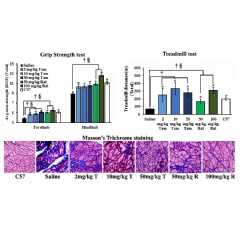Tamoxifen and raloxifene slow down the progression of muscular dystrophy
Long-term treatment with selective estrogen receptor modulators (SERMs) improves muscle, respiratory, and skeletal function without weakening bone in new mouse studies, according to a new report in The American Journal of Pathology

Steroids are currently the only available treatment to reduce the repetitive cycles of inflammation and disease progression associated with functional deterioration in patients with muscular dystrophy (MD). A studyreported in The American Journal of Pathology showed that a new treatment approach using the selective estrogen receptor modulators (SERMs) tamoxifen and raloxifene significantly improved cardiac, respiratory, and skeletal muscle functions and increased bone density in both male and female mice with the same gene defects as a subset of patients with MD.
“Our results show that there are two important advantages of tamoxifen and raloxifene treatment over steroids, which have limited benefits for patients with MD. First, the SERMs improve both histology and function of all muscles; although steroids improve histology, they improve function to a much lesser extent. Second, SERMs enhance bone density, whereas steroids exacerbate osteoporosis and increase the risk for fractures,” explained Qi Long Lu, MD, PhD, director of the McColl-Lockwood Laboratory for Muscular Dystrophy Research, Neuromuscular/ALS Center, Department of Neurology, Atrium Health’s (formerly Carolinas HealthCare System’s) Carolinas Medical Center, Charlotte, North Carolina, USA.
The mice used in this study have the identical gene defects and show almost the same disease manifestation as patients with MD and are therefore an excellent model for therapeutic evaluation. Investigators administered tamoxifen (2, 10, or 50 mg/kg), raloxifene (50 or 100 mg/kg), or saline to mutant mice with dystroglycanopathy, a form of MD, for up to a year, beginning at three weeks of age.
The investigators found several indicators that tamoxifen and raloxifene delay or even halt disease progression. Within one month, treatment with either SERM reduced muscle pathology with significant reduction in the numbers of degenerating fibers. After a year, control mice showed high variation in fiber size with focal inflammatory infiltrations, but these dystrophic changes were much less evident after tamoxifen or raloxifene. A noticeable reduction in collagen accumulation in limb muscles for all treatment groups vs controls was observed. Importantly, treatment with SERMs clearly mitigates muscle damage and enhances functions of both respiratory and cardiac muscles in addition to the limb muscles.
Other benefits were also observed. Control mice showed progressive muscle degeneration and regeneration in the diaphragm, accompanied by increasing fibrosis and infiltration, as well as significant impairment in respiration. Both tamoxifen and raloxifene eliminated focal infiltration and reduced the extent of fibrosis in the diaphragm, increased mass, and improved breathing ability. “Both treatments also improved bone density in the tibia and femur, potentially reducing the risk of fracture, a major threat to patients as MD progresses,” added co-author Bo Wu, PhD, a research scientist at the McColl-Lockwood Laboratory for Muscular Dystrophy Research, Neuromuscular/ALS Center, Department of Neurology, Atrium Health’s (formerly Carolinas HealthCare System’s) Carolinas Medical Center.
These histological changes were accompanied by functional improvements. For example, SERM treatment improved grip strength of both forelimb and hindlimb muscles and enhanced running ability on a treadmill test depending on the dose.
Sex-related differences in the effects of tamoxifen and raloxifene warrant careful consideration if the drugs are to be administered clinically for MD, noted the investigators. This is not surprising since SERMs act on estrogen receptors and interact both as estrogen-receptor agonists and antagonists.
“SERM therapy has great potential to significantly delay or halt MD progression. With the vast amount of safety data available, the selective use of tamoxifen and raloxifene in male and female patients with MD is an attractive and realistic alternative to steroids,” noted Dr. Lu. This together with the detailed analyses of potential side effects and benefits in male and female populations provide rationale for early clinical trials. Importantly, the beneficial effects of SERMs are expected to extend to other forms of MD, beyond the specific mouse model investigated here.
-------
The article is “Long-Term Treatment of Tamoxifen and Raloxifene Alleviates Dystrophic Phenotype and Enhances Muscle Functions of FKRP Dystroglycanopathy,” by Bo Wu, Sapana N. Shah, Peijuan Lu, Lauren E. Bollinger, Anthony Blaeser, Susan Sparks, Amy D. Harper, and Qi Long Lu (https://doi.org/10.1016/j.ajpath.2017.12.011). It will appear in The American Journal of Pathology, volume 188, issue 4 (April 2018) published by Elsevier.
This research was supported by the Carolinas Muscular Dystrophy Research Endowment at the Carolinas HealthCare Foundation.
About The American Journal of Pathology
The American Journal of Pathology, official journal of the American Society for Investigative Pathology, seeks to publish high-quality, original papers on the cellular and molecular biology of disease. The editors accept manuscripts that advance basic and translational knowledge of the pathogenesis, classification, diagnosis, and mechanisms of disease, without preference for a specific analytic method. High priority is given to studies on human disease and relevant experimental models using cellular, molecular, animal, biological, chemical, and immunological approaches in conjunction with morphology. http://ajp.amjpathol.org
About Elsevier
Elsevier is a global information analytics business that helps institutions and professionals advance healthcare, open science, and improve performance for the benefit of humanity. Elsevier provides digital solutions and tools in the areas of strategic research management, R&D performance, clinical decision support, and professional education; including ScienceDirect, Scopus, SciVal, ClinicalKey and Sherpath. Elsevier publishes over 2,500 digitized journals, including The Lancet and Cell, more than 35,000 e-book titles and many iconic reference works, including Gray’s Anatomy. Elsevier is part of RELX Group, a global provider of information and analytics for professionals and business customers across industries. www.elsevier.com
( Press Release Image: https://photos.webwire.com/prmedia/6/221703/221703-1.jpg )
WebWireID221703
This news content was configured by WebWire editorial staff. Linking is permitted.
News Release Distribution and Press Release Distribution Services Provided by WebWire.